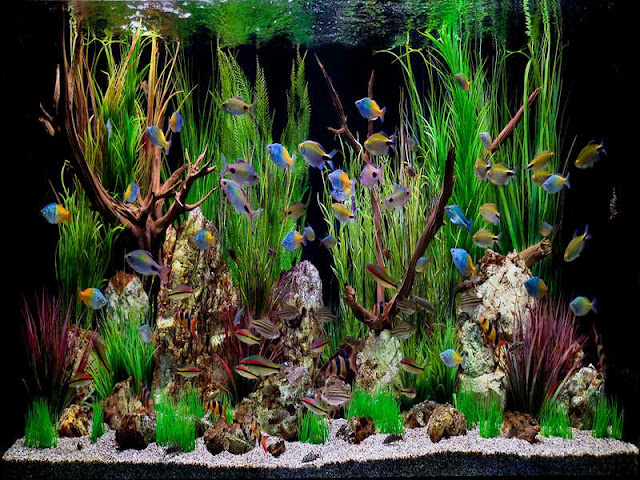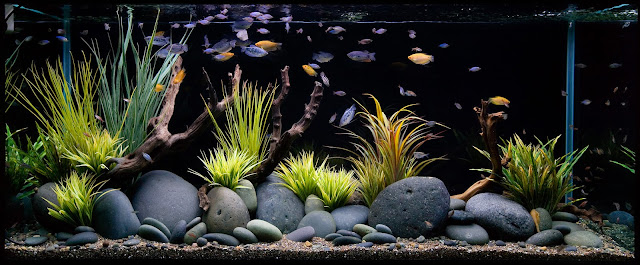A variety of eight
freshwater aquarium fish you can put in your aquarium. Scientific names, preferred conditions, colors description, sex differences and breeding advice are given.
American Flag Fish – Jordanella floridae (Family: Cyprinodontidae)
Aggressive but a pair may be ok in a community tank if the others are of a similar size. Prefers 20 to 22ºC. Blue to yellowish-green with an iridescent sheen. Female is paler in color with a dark spot on the dorsal fin. Breed in a thickly planted tank.
Male normally forms depression in gravel and female puts eggs in this area. Remove female immediately after spawning.Rear fry on algae and freshly hatched brine shrimp.
Argentine Pearl – Cynolebias bellotti (Family: Cyprinodontidae)
Best in a small shoal if it is a community tank and 21 to 26ºC. Adult can grow to about 7.5 cm. Its body color is generally a dark shade of green with light blue or pearly white spots scattered over the body and vertical fins.
The eye has a dark stripe passing through it. Females are smaller and yellowish green with irregular dark brown vertical stripes – quite dissimilar. Not easy to breed and even if they do hatch the fry may not reach maturity.
Beacon Fish – Hemigrammus ocellifer (Family: Characidae)
Popular community fish as it is peaceful and hardy. Best in water between 20 and 26ºC. Incorporate a high percentage of live food in its meals. Light greenish brown body color with yellow and red iris. Male is slimmer and smaller than the female.
Fairly easy to breed but use two males per female with water at 25ºC and 25 cm deep for the breeding tank. Eggs will stick to fine leaved plants in the tank. Remove fish after spawning. Fry hatch after about three days.
Bloodfin – Aphyocharax anisitsi(Family: Characidae)
Good for community tank as they are peaceful and only grow to about 5.5 cm. 25ºC temperature, a small shoal and well lit tank are best conditions. Silvery green color with red fins (apart from pectorals). Female color is less dark and no white tip on ventral and anal fins.
Breed in large tank with 15cm water at 24ºC and well planted with both tall and short plants. Spawning takes place in the early hours as both fish meet above the water surface and the non-stick clear eggs are scattered over a wide area. Remove adults after spawning.
Bumble Bee Fish – Brachygobius nunus (Family:Gobiidae)
Not a very active fish as it keeps still on a rock or plant for more than an hour at a time. Maximum size of 4.5 cm. Needs lots of hiding places and a teaspoonful of salt in the tank is preferred. Golden yellow body color and four dark bands. Breeding is not easy.
Checkered Dwarf Cichlid – Apistogramma ramirezi (Family: Cichlidae)
Grows to 6 cm and prefers a tank with plenty of hiding places. Not a very long-lived species. Purplish-red is the body coloring with iridescent green or turquoise spots. Will look different as the light changes. Not easy to tell a male from a female.
For breeding, densely plant one end of the tank and have a sandy bottom with pieces of slate on it. Adhesive eggs will be laid on the slate and remove the slate to another tank once laid. Eggs will hatch in three days at 26ºC.
Clown Barb – Barbus everetti (Family: Cyprinidae)
A larger fish (growing to 13 cm) and good for a community tank at a temperature of 22ºC. Yellowish-pink body color with blue or gray patches. Female is larger and thicker than the male and has pink fins, compared to red in the male. Difficult species to breed. Closely related species which are smaller in size include Barbus titteya (Cherry Barb), Barbus nigrofasciatus (black ruby), Barbus conchonius (rosy barb) and Barbus sachsi (golden barb).
Combtail Paradise Fish – Belontia signata (Family: Belontiidae)
Due to its aggressiveness not suitable for a community tank. Needs plenty of hiding places and a temperature of 2ºC above the normal tropical range. A larger fish growing to 12.5 cm. Male colors vary from greenish-brown to deepish red on the back , gradually changing to a greenish blue on the belly. Females are smaller and the color is more yellowish-brown overall.
Breeding tank should be at 29ºC and adults kept apart beforehand and fed on live food. The tank should be heavily planted plus have floating plants where the eggs will be laid. Feed fry on infusoria after two days when they have eaten their yolk-sacs.










Comments
Post a Comment